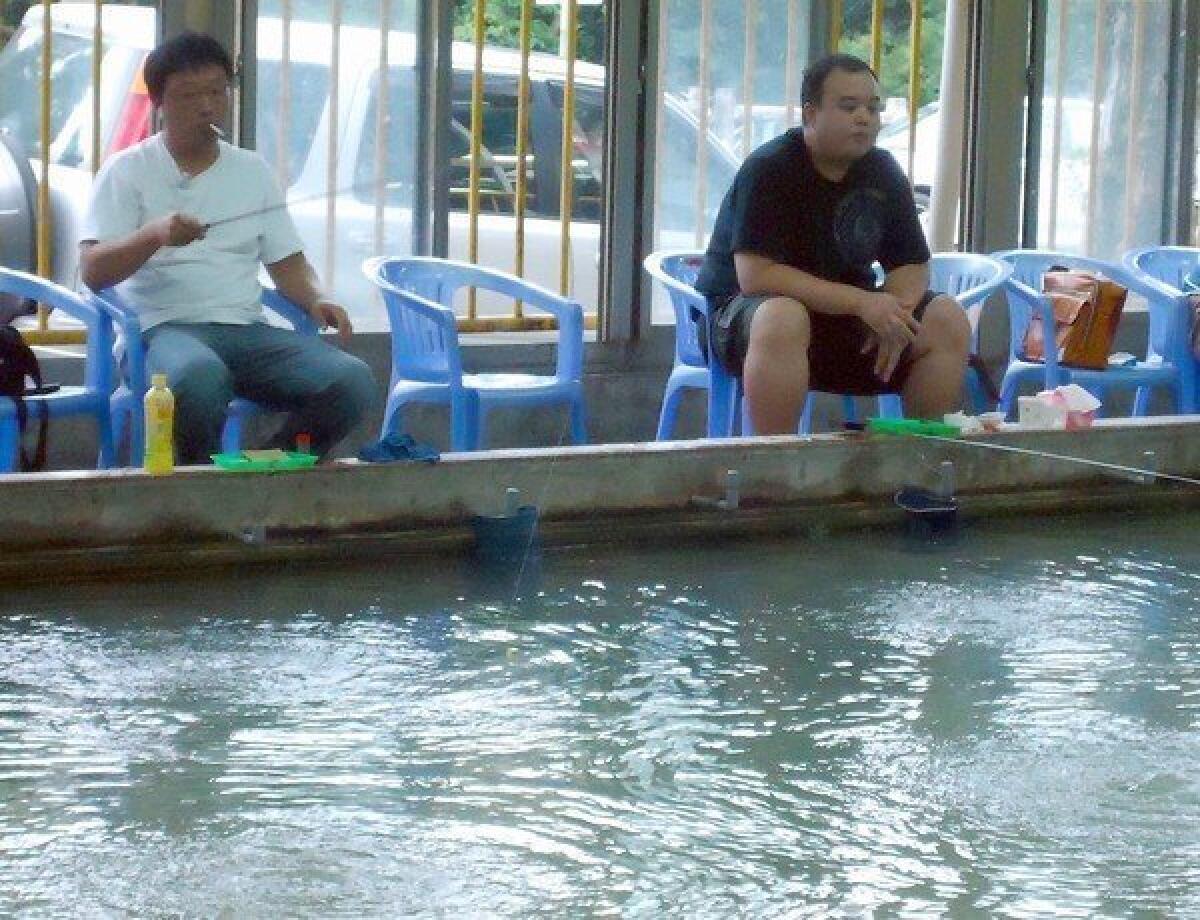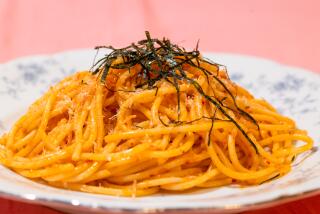In urban Taiwan, indoor shrimp fishing is booming

- Share via
TAIPEI, Taiwan — Ben Lan threw a line in the water one recent afternoon and caught two fair-sized specimens in 10 minutes. With 10 years of experience, the 60-year-old retiree stood out from a couple of fellow anglers who looked on with envy.
It’s not unusual to hear a cheer go up when somebody lands a big one. Big means about 6 inches.
That’s because Lan and the others were casting for shrimp.
“It’s a leisure activity. Taiwan is too small, and there’s nothing else to do,” Lan said as he stuffed a just-caught live shrimp into a net suspended in the water at an indoor pool just outside urban Taipei.
Lan was one of a couple of dozen shrimp hunters who sat around the rectangular, concrete-walled 538-square-foot shrimp pool that weekday afternoon. They joined countless thousands of others in following an only-in-Taiwan trend that has grown popular enough to spawn websites on shrimp-baiting techniques and offers to meet for shrimp dates.
Operators of shrimp pools call it a form of recreation that evolved from the west Pacific island’s historical fixation on fishing. Over the years, fishing has become more difficult due to Taiwan’s urbanization. What’s more, sitting for hours on a windy, rainy pier has, for many, lost its luster.
Shrimp casting began outdoors in southern Taiwan about two decades ago. The sport eventually worked its way inside to satisfy city dwellers.
“Shrimp fishing is suitable for older people and children,” said Lin Shu-te, a senior staff member at the Shuang Cheng Leisure Shrimp pool in the hills of Taipei. “At sea, the sun is strong or wind is strong, but in here, those aren’t issues.”
With so many people sitting around murky pools waiting for bottom-crawling shrimp to bite, the recreation has morphed into a full-blown source of entertainment for dates, families or men on their day off from work. Some guys sip beer or chew betel nut — a legal stimulant in Taiwan — and chat while waiting for bites.
“You can feel proud and invite your friends to eat [shrimp] together,” said George Hou, an associate professor specializing in media and entertainment at I-Shou University in the southern city of Kaohsiung. “It’s done mostly in the evening. You can kill time. There’s no safety problem. And you can get some beers.”
Shrimp casting, regardless of the haul, costs $6 to $11 an hour, and the average stay is about two hours. Those keen on a long party may settle in for a late-nighter, as many pools stay open 24 hours.
“The rates are cheap, and the pool operators give you the equipment on site, though professionals will bring their own,” noted Taipei shrimp pool customer Chen Hsiao-tang. “You come and pay pocket change, that’s it.”
Chen caught a personal record of 15 shrimp in two hours at Chuencheng, one of the older pools in Taipei with 20 years in business and which easily attracts more than 100 customers at a time on weekends. One website lists about 70 commercial shrimp fishing pools in the island’s capital, Taipei, a 40% increase over estimates from three years ago.
Catching a shrimp isn’t as easy as it looks. Experienced anglers suggest measuring the depth of a pool to know how far to drop a line. One never knows how many shrimp the house has released into a pool, and they usually cluster at the bottom. Line in the water, baited ideally with fish eggs, the next phase is a wait of up to 30 or even 60 minutes.
Thai shrimp, which despite the name are raised in Taiwan, frequently fight back, dropping back into the pool if they win.
“Everyone’s skill, likewise the design of the rod, is different,” said Lin of Shuang Cheng Leisure Shrimp. “For old hands, more than 10 shrimp per hour isn’t bad, and there’s no guarantee that a new hand will get even one per hour.”
The longer the wait, the bigger the reward, said Chen Ke-chi, chef and co-owner of 258 Live Shrimp in the central Taiwanese city of Taichung.
Those with neither skill nor time can order from 258 Live Shrimp’s menu of 16 prepared shrimp dishes. It takes about a dozen or more average-sized shrimp, along with a vegetable dish, to make a meal for two.
At Chuan Chia Leh, a 22-year-old air-conditioned downtown Taipei shrimp pool, up to 40 people cast their lines as late as 3 a.m.
“Internet dates, organized groups and even contests come here, like seven or eight, 10 people together. They might even charter the whole venue,” owner Tsai Yao-cheng said. “And a lot of people who come here get to know one another as they cast.”
As part of the hourly rate, shrimp pools usually let customers grill their catch on site with coatings of salt, soy sauce and wasabi. The final step: eating it by the pool, along with a side of stir-fried cabbage or a few bottles of beer.
Jennings is a special correspondent.
More to Read
Sign up for Essential California
The most important California stories and recommendations in your inbox every morning.
You may occasionally receive promotional content from the Los Angeles Times.










